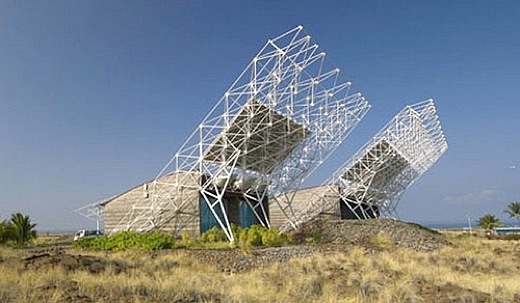SUBHEAD: 2010 World Congress on Zero Emissions to explore Native Hawaiian practices on Ahupuaa.
Image above: The NELHA Hawaii Gateway Energy Center (HGEC) on Kailua Kona is a sustainable, zero-net energy multi-use facility. From article.
By Jamie Winpenny on 31 August 2010 for the Hawaii Independent -
The Ancient Hawaiian ahupuaa system of land management evolved to protect its natural resources and supported a thriving population. Today, Hawaii’s brightest minds are looking to combine the latest modern technology with traditional ways of managing our islands’ resources in order to live sustainably.
Enterprise Honolulu is a nonprofit organization that facilitates work on Hawaii’s infrastructure and planning issues in order to move the state towards energy independence and food self-sufficiency.
At the World Congress on Zero Emissions Initiatives from September 13 to 17 at the Hawaii Convention Center, Enterprise Honolulu will share how innovations related to food, water, housing, health, energy, transportation, and waste will provide new job opportunities in Hawaii.
The congress will also explore ways to integrate human production, consumption, and waste systems using established indigenous and ecological resource management models, as well as proven technologies as discussed in the upcoming book The Blue Economy by keynote speaker Gunter Pauli—the founder of Zero Emissions Research Initiatives.
The conference features an impressive roster of international keynote speakers, among them master navigator and Hawaiian culture scion Nainoa Thompson. Bhutan’s Honorable Minister of Education Lyonpo Thakur S. Powdyel will be discussing his country’s adoption of the concept of Gross National Happiness, which prioritized sustainable development and the preservation of cultural and environmental resources. Dozens of local experts on these subjects are also slated to speak.
The conference will also feature a wide range of exhibitors, government agencies, and green-thinking businesses.
A youth program on Thursday, September 16 will offer up to 1,000 Hawaii students the chance to speak with the keynote speakers about new ways to innovate.
Mark McGuffie is the managing director of Enterprise Honolulu’s Oahu Economic Development Board. The Hawaii Independent asked Mr. McGuffie a few questions about the World Congress on Zero Emissions.
What is the most immediately actionable goal of the Congress on Zero Emissions?
One of the goals of The World Congress on Zero Emissions Initiatives is to realize that we can achieve abundance in our systems for human needs in the areas of energy, food, health, housing, transportation, waste, and water by using what we have.
Today, systems in these areas are not fully integrated—often wasteful and designed in silos rather than using an inclusive process. This is a time to come together with experts and people from around the world interested in solutions to learn and share about innovations that are proven. We are dedicating time to address “conflict resolution in a system” as a vital part of this process.
One of the stated goals of the Congress is to build “social capital.” Please explain what this means and how it can be achieved.
Building social capital is the ability to tell the story large enough for everyone to see their role being included as a stakeholder in a more prosperous future.
What specifically about the indigenous native Hawaiian ahupuaa resource management system resonates with Zero Emissions Research Initiatives?
The ahupuaa is a prosperity model. Not a sustaining model. After many years of refinement, the ahupuaa was designed to ensure that everybody and everything thrived. All natural resources were managed to improve rather than deplete. Everyone had a role to that end—kuleana.
How do we bring this wisdom forward to today? Only 250 years ago Hawaii had a thriving population. Everyone was fed, housed, and nurtured. There were no imports, no exports, and no waste. The overarching value of aloha prevailed for each other and everything. I leave you with these questions: What could/should the modern ahupuaa look like to you?
See also:
.

No comments :
Post a Comment